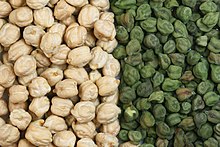
Back Kekerertjie Afrikaans Kichererbse ALS ሽምብራ Amharic حمص شائع Arabic ܚܪܛܘܡܢܐ ARC حمص شائع ARZ বুট Assamese Cicer arietinum AST Qoyunnoxudu Azerbaijani نوخود (نؤوع) AZB
| Chickpeas | |
|---|---|

| |
| Dried chickpeas. The larger light tan kabuli and variously coloured desi are the two main types of chickpea. They are green when picked early and vary through tan or beige, speckled, dark brown to black. Seventy-five percent of world production is of the smaller desi type. | |

| |
| Sprouted chickpea | |
| Scientific classification | |
| Kingdom: | Plantae |
| Clade: | Tracheophytes |
| Clade: | Angiosperms |
| Clade: | Eudicots |
| Clade: | Rosids |
| Order: | Fabales |
| Family: | Fabaceae |
| Subfamily: | Faboideae |
| Genus: | Cicer |
| Species: | C. arietinum
|
| Binomial name | |
| Cicer arietinum | |
| Synonyms[1] | |
| |

The chickpea or chick pea (Cicer arietinum) is an annual legume of the family Fabaceae, subfamily Faboideae.[2][3] Its different types are variously known as gram[4][5] or Bengal gram,[5] chhola, chhana, chana, or channa, garbanzo[5] or garbanzo bean, or Egyptian pea.[4] Chickpea seeds are high in protein. It is one of the earliest cultivated legumes, the oldest archaeological evidence of which was found in Syria.[6][7][8]
The chickpea is a key ingredient in Mediterranean and Middle Eastern cuisines, used in hummus, and, when soaked and coarsely ground with herbs and spices then made into patties and fried, falafel. As an important part of Indian cuisine, it is used in salads, soups and stews, and curry, in chana masala, and in other food products that contain channa (chickpeas). In 2022, India accounted for 75% of global chickpea production.[9]
- ^ "Cicer arietinum L." The Plant List. 2013. Retrieved 22 October 2014.
- ^ Feedipedia. "Chickpea (Cicer arietinum)". www.feedipedia.org. Retrieved 26 February 2018.
- ^ Kew Science. "Cicer arietinum L. – Plants of the World Online". Plants of the World Online. Retrieved 26 February 2018.
- ^ a b "Baynes, T. S.; Smith, W. R., eds. (1880). . Encyclopædia Britannica. Vol. 11 (9th ed.). New York: Charles Scribner's Sons. pp. 36–37.
- ^ a b c "Cicer arietinum". Germplasm Resources Information Network. Agricultural Research Service, United States Department of Agriculture. Retrieved 21 October 2014.
- ^ S, Bell (March 31, 2014). "The small but mighty chickpea". Phys.org. Retrieved 8 October 2015.
- ^ Advances in Agronomy. Elsevier. 2001. ISBN 978-0080543994. Retrieved 26 February 2018 – via Google Books.
- ^ Lucas, Leilani; Fuller, Dorian Q. (2014), "Chickpea: Origins and Development", in Smith, Claire (ed.), Encyclopedia of Global Archaeology, New York, NY: Springer, pp. 1384–1387, doi:10.1007/978-1-4419-0465-2_2324, ISBN 978-1-4419-0465-2, S2CID 82687381, retrieved 2023-12-24
- ^ Cite error: The named reference
faostatwas invoked but never defined (see the help page).
© MMXXIII Rich X Search. We shall prevail. All rights reserved. Rich X Search